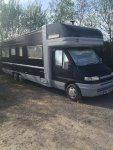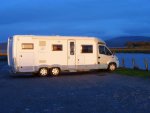Hi Gang,
I’m a Full time Livaboard of the last 7 years, Have a 4.500KG Tag axel That’s 30ft from Bumper to Bumper & ‘Wildcamp’ most of the time all year around as I travel All Over the UK.
Have I been stuck,,,,Yep
& on one occasion down to my Axel. Nothing a Shovel a Jack My Wheel Boards & a few harsh words couldn’t cope with, & to be fair it’s all part of my chosen lifestyle.
Handling problems,,,,None
I’ve been in & Over Mud, Snow, Ice, Tracks, Lanes, Roads & Motorways all fine, Let’s be honest it’s down to the Actual Motorhome Load & Tyre Set Up & the Driving Experience of the Driver At the end of the day, Among one of the most important lessons is to know when to Stay Put or move from park ups around the Ground & Weather Fronts Or conditions. But this is the same for any vehicle you might be driving.
Overhang,,,,Never been a problem to Me or The Nest.




In the last picture you can see The Nest on the Wheel Boards that I carry & use for softer Ground, This Park Up was in a field by a Hedge line while having a meet up with a friend & Fellow Livaboard for a few days a cpl of Weeks ago.





